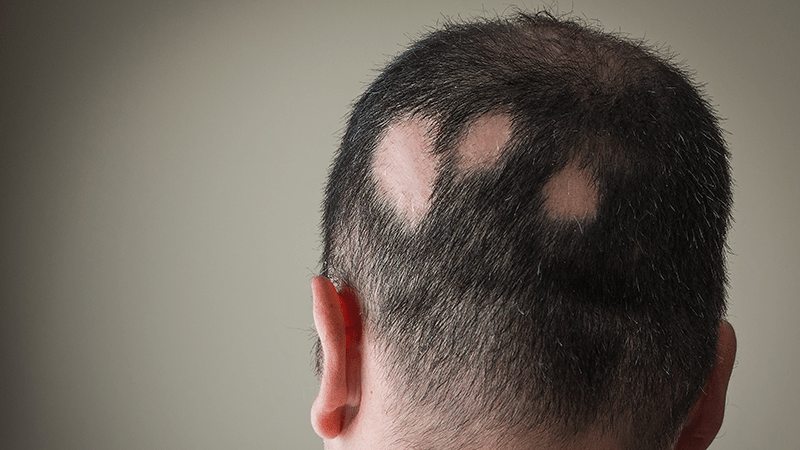Circular, clearly defined bald patches – these are the telltale signs of circular hair loss, also known as alopecia areata. The hairless patches can appear anywhere on the body where hair usually grows. The hair on the head is most commonly affected, but the eyebrows, beard and other areas of body hair can also develop circular or oval patches. Initially, circular hair loss only affects one area. Sometimes it goes no further than this, but many sufferers do go on to develop more bald patches. It is often impossible to stop the condition from progressing. If the hair loss continues, it can turn into alopecia universalis, which is when someone loses all the hair on their body. This is rare, however.
Circular hair loss – a hair loss condition with a long history
Circular hair loss affects around 1.4 million people in Germany, making it the most common illness-related form of hair loss. Alopecia areata affects men, women and children, and has been known about for a very long time. Hippocrates made mention of it as long ago as 400 B.C. The name ‘alopecia areata’ can be traced back to foxes who were affected by the condition and whose fur fell out in circular spots. But what Hippocrates couldn’t work out was what actually caused this type of hair loss.
What causes circular hair loss?
We now know that circular hair loss is triggered by an autoimmune condition. The sufferer’s immune system identifies its own hair follicles as foreign bodies and destroys them. This causes the hair in the affected areas to fall out, and it often doesn’t grow back again. It’s usually the hair on the head that’s affected, but circular hair loss in the beard is also common. The condition can appear in childhood or adulthood. In some cases, circular hair loss is accompanied by skin conditions such as neurodermatitis. Because alopecia areata is a genetic condition, it will sometimes affect several members of the same family.
When someone is genetically predisposed to circular hair loss, the condition can be triggered in them at any time by a stressful event such as a bereavement, important exams or an accident.
The prognosis with circular hair loss
The progression of circular hair loss varies from person to person. In some sufferers the hair loss is permanent, whilst in others the hair grows back after a while. If the hair does suddenly grow back, it will be very thin and usually white or colourless. The pigment doesn’t return until later. Recovery often comes in cycles, and the hair may fall out again after a while. The prognosis for recovery is better the less time someone has been suffering from alopecia areata.
Circular hair loss – treating the symptoms
We still don’t know why the body suddenly develops an immune reaction to its hair roots. That’s why there is still no medication proven to stop circular hair loss. There have been numerous experiments with skin irritants, which are supposed to cause external inflammation and stimulate the hair to grow back. The external application of cortisone is a popular treatment for circular hair loss. Experienced doctors can also inject cortisone under the skin. They have to be careful not to inject the cortisone too deep, however, so the active ingredient doesn’t trigger side effects in the whole body.
Circular hair loss is often very distressing for those affected, so it can be helpful to talk to other sufferers. Coming together to talk about their hair loss can help sufferers of alopecia areata come to terms with their condition and develop coping strategies for everyday life.
Long-term help for circular hair loss
With alopecia areata there’s no way of knowing whether your hair will ever grow back or not, so many sufferers are keen to find a long-term solution. A hair transplant is not an option for people with circular hair loss, however, because the body would continue to attack the hair roots and the hair would simply fall out again. If the condition spreads, one solution is to wear a wig to hide the hair loss.
The only long-term and truly effective way of concealing alopecia areata is scalp micropigmentation. This involves applying pigments to the scalp to make the hair look fuller. In combination with a close-shaven cut for the remaining hair, this creates a completely natural appearance. The scalp micropigmentation method can help men enjoy a stylish close-shaven look. But it can improve women’s quality of life too. Women may choose to wear a wig in public to create the appearance of long hair. But thanks to scalp micropigmentation, even when they take the wig off at home, their bald patches can no longer be seen. The head never looks “naked”, which gives an enormous boost to the sufferer’s wellbeing.
Do you suffer from circular hair loss or another form of alopecia?
We can help you create a full and even look for your hair using scalp micropigmentation. Just call us or send us a WhatsApp today!
